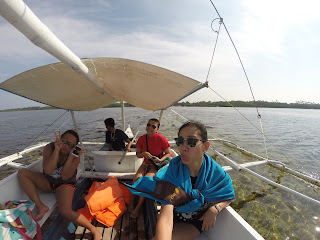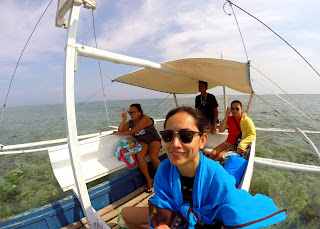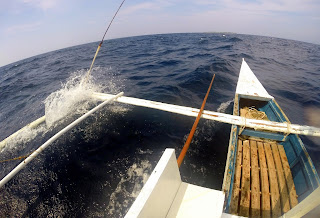**Update: Los Conquistadores, of course. Gracias, Lics.**
Bohol: Day 3 of 5.
We didn't have to wake up so early today. Praise Jesus.Today, we dive. And today was the worst possible day to put a bikini on yourself.
So. Much. Soreness. All. Over.
However, let me give you a preview of one of Balicasag's dive spots. And if you're just starting to dive, the sight of the reef and it's teeming wildlife should convince you enough to pursue open water.
 |
| Pretty purples. |
Cruising the Bohol Sea
Lica and Abi would probably call me out for using the term cruise.I had given Mang Biloy (a Balicasag resident, and a very dear family friend) the heads up that we had plans to go to Balicasag Island days before our trip. He said he would gladly pick us up at Doljo Beach which is conveniently located behind our residence, less than a 5-minute walk.
On the day we arrived Bohol, I called him again. He told us that he would try his best to pick us up for Balicasag on our third day, as the waves were exceptionally strong. We all hoped that Typhoon Ineng would have left the country by then.
The weather was beautiful on the day we were to set sail for Balicasag. Unfortunately, Mang Biloy had his friend from Panglao pick us up, as his smaller vessel might not be equipped enough to handle the tamed, but still choppy waters.
 | |
| Photo credit: Google Maps (Earth view) |
That tiny island near the tip of Panglao is Balicasag Island.
Manong "Panglao friend" and a companion picked us up via motorcycles, and from the house, took us to the port in Poblacion. We boarded the outrigger canoe near the mangroves, and manong and his companion carefully maneuvered the boat around the surrounding parked ones to head out to sea.
 |
| Lagu-turned-scarf. The sun was scorching. |
The boat ride to Balicasag Island from Panglao normally takes around 30-45 minutes. The surrounding waters of the Panglao Bay were gently pushing us out to sea. Manong Pf had to shut the motor off and manually move the craft around carefully upon reaching the reef area of Panglao, to avoid hitting and doing damage to the reef.
 |
| Shallow area. |
However, upon exiting Panglao Bay (and reef), we saw what Mang Biloy was talking about.
The sea seemed to be turbulent, and waves felt as if they were getting stronger each minute. We weren't that alarmed, although sometimes it felt that we were banking too much on one side when we were slicing through a bigger swell. The waves didn't seem harmful (or huge), but I missed Mang Biloy's technique. Instead of dealing with the surf head on and just slicing through it with the motor in full power, Mang Biloy "studies" the wave patterns and rhythm first, reduces his speed, glides his craft around the swell, making it seem that we're riding the waves (kinda like surfing). In the end, it's a smooth(er) ride until we dock. Just how a PAL pilot is OC with his/her entire flight, not just takeoffs and landings. (And no, I am not being biased.)
 |
| Keep calm, and kapit to death. |
Soon enough (and many more waves after), we reached Balicasag Island. Drenched and all.
Mang Biloy's and Manang Glo's warm smiles greeted us at the dock. It was great to be back, and it felt so good seeing them.
Mang Biloy then showed me why he could not pick us up from Panglao. The Saint Vincent, his larger watercraft, has been broken nearly in half when Typhoon Queenie (International name: Sinlaku) hit the island November of last year and did a lot of destroying, boats included. It was gut-wrenching; he had just renamed the Saint Vincent to "A330", my dad's aircraft.
Balicasag Island
Let me bore you with details for a bit:Balicasag is a 400m marine sanctuary, characterized by lots of vertical walls over deep waters. There are occasional butandings and hammerhead sightings, especially if you dive December or January. (NOTE TO SELF!)
The etymology of Balicasag's name is not really known. I probably read somewhere (though I couldn't remember where, or if my sister, Trina, was the one who shared this info with me) that "bali" meant island in another language, and "casa" is Spanish for house. "Bali" "casa" may mean 'island house' or 'island home', though I would never know where the 'g' came from.
Island Reefs:
- The Resort Wall: The reef is a few meters from the shore in front of Balicasag Island Dive Resort. This is usually where they bring their intro divers (where we did ours as well). After a bit of swimming around, you'd reach the "drop off" wall, which starts at 3m (or approximately 10ft), and descends to up to 83m (approximately 270ft.)
- Black Coral Forest (or Black Forest: A slope that starts at 5m (16ft) going down to 30m (98ft), and counting. It's named after the black corals (duh) found abundantly in the area. A black coral's living tissue is brilliantly coloured; it's "skeleton" is distinctively black (or dark brown).
- Cathedral Wall: Balicasag boats go sometimes to take guests snorkeling and fish feeding at the 8m (26ft) shallow area. Dive deeper, and there are walls, overhangs, gaps, ledges, and caves. On sunny days, the sun's light bounces off the colorful corals and sponges, giving you the feel of being inside a cathedral: stained windows, sun's rays and all. (Feel holy yet?)
- Turtle Point: Omg turtles! (ADD mode on, sorry.) It's a place where turtles hide in caves, 20-25m (65-80ft) below. No turtles? No problem. There are heaps of cushion and feather starfish surrounding the outside of the cave, and more fish to see. (No Patrick Star, sorry.)
- The Cavern: It is called such because of several small caves on the drop off wall, 20-25m below. More importantly, The Cavern is part of the Danajon Bank (or the Danajon Double Barrier Reef), the ONLY double barrier reef in the Philippines, and one of only six in the world. The Danajon Bank is the core of marine biodiversity, and one of the most important ecosystems in the entire Pacific Ocean. Night dives are the best for this one.
Sources: Bohol Philippines, Saving Danajon Bank
Anyhooo... we walked to the Balicasag Island Dive Resort, and met up with Tita Mayene (another family friend). She was the one who booked us three for diving, and instructed us to proceed to the dive shop as soon as we have dropped off our things at the concierge.
TO BE CONTINUED


No comments:
Post a Comment